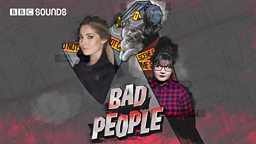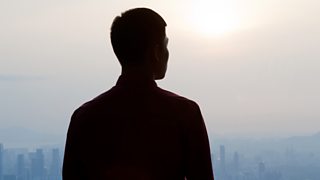The myths that silence male victims of rape
Warning: The article contains content that some people may find upsetting.
On this week’s episode of the Bad People podcast on �鶹�� Sounds, Sofie Hagen and I discuss the case of Reynhard Sinaga, a man who has been referred to as the UK’s most prolific rapist. The perpetrator, an unassuming doctoral student who lived in Manchester at the time, is thought to have sexually assaulted at least 195 men between January 2015 and June 2017.
It is a case which brings several things into stark focus. It shows the lack of discussion we have about male victims of rape. It also shows the prevalence of male rape myths, which manifest dramatically in Sinaga’s victims after they were informed what happened and were presented with the option of seeing videos of themselves being raped while in an incapacitated state. In addition to the high potential for trauma that this presented, it exposed internalised rape myths.

How often are men the victims of rape?
In some ways the Sinaga case is highly unusual, and in others it is entirely in line with statistics on male rape.

43% of male rape or assault by penetration is perpetrated by a stranger (compared to 15% for women)."
For the year ending March 2020, (CSEW) statistics show that when looking at all victims of all genders, 98% of perpetrators of rape or sexual assault by penetration were male. While men can be sexually assaulted by women and people of other genders, by far the most common perpetrator is another man. Sinaga also targeted almost exclusively strangers. Men are far more likely than women to be raped by strangers - 43% of male rape or assault by penetration is perpetrated by a stranger (compared to 15% for women).
The fact that he exclusively chose male victims was somewhat more unusual, but not as unusual as we might intuit. In the CSEW 2020, approximately 3 in 100 women and 1 in 100 men reported having experienced some form of sexual assault in the previous year. Specifically related to rape or assault by penetration, 0.04% of men and 0.61% of women reported they had been the victims over the past 12 months. That’s fifteen times more women than men, but it still means that a high number of men were raped in 2020.
Something that was unusual about Sinaga was his systematic criminal method. He would lure men into his flat under various pretences that often made him seem like a good Samaritan. Once in his flat, he would offer them a drink that was laced with GHB, a drug that rendered his victims unconscious and prevented memory formation. In the CSEW 2020, 5% of victims of rape or assault by penetration (across all genders) reported that they thought that the perpetrator had drugged them.
The victim who reported him in 2017 woke up while being raped and quickly called the police, who uncovered the hundreds of videos Sinaga had made of his crimes. However, because of the GHB, most of Sinaga’s victims did not know they had been raped until the police told them. Victims whom the police have been unable to track down probably still don’t know. For those who have found out about this dark revelation about themselves there has often been a mountain of male rape myths to overcome in the psychological recovery process.
What are male rape myths?
There is considerable overlap in male and female rape myths but there are some important gender-related differences that deserve our attention. To help measure these, in 2021 Ben Hine and colleagues created the , with two categories.

There is considerable overlap in male and female rape myths but there are some important gender-related differences that deserve our attention."
The first is “Blame”, and includes victim blaming, toxic views of masculinity, and a denial of consequences for men who are victims of sexual assault.
These myths include:
• ‘Real men’ cannot be raped;
• Male victims of rape have very little emotional trauma to cope with;
• A man who is raped must have been behaving in a way that made him appear homosexual;
• If a man has been raped he should be able to cope on his own;
• If a man has already had consensual sex with other men, his claims of rape should not be believed;
• Only men who are big and strong are able to rape other men.
Sinaga’s case is useful for providing an example that debunks all of these. Sinaga was a gay man of average stature, who deliberately targeted heterosexual men. Many of his victims were larger and stronger than him, including the victim who reported him to the police. And, many of his victims continue to suffer from severe emotional trauma and need psychological support.
The second category of rape myths is “Minimisation/Exoneration” and includes making excuses for the perpetrator and presenting a stereotypical image of rapists.
These myths include:
• Regardless of how they identify themselves, men who rape other men are homosexual;
• Men who commit rape are naturally more aggressive in their day to day lives;
• Most cases of male rape include the use of a weapon;
• Most men would be able to fight off a male sexual attacker;
• Almost all male rape occurs in institutions such as prisons or the military.
Again if we were to believe these myths, we might wrongfully classify Sinaga as incapable of his crimes. To others, Sinaga seemed kind and gentle, he didn’t need a weapon, his victims were unable to fight him off because they were unconscious, and he committed all his crimes in his flat and in a context where he could have easily approached men for consensual sex. And, although Sinaga was homosexual, of course men who identify as heterosexual can also rape other men. Rape is an act of violence which can be separate from a desire for sexual gratification.

Debunking these ideas is important because people who believe rape myths are more likely to be perpetrators of sexual assault."
Debunking these ideas is important because people who believe rape myths are more likely to be perpetrators of sexual assault, and victims who believe rape myths are less likely to report assault or seek help to deal with the psychological consequences of it.
Anyone who thinks they may have been affected by Sinaga’s crimes, come into contact with him under similar circumstances, or someone like him, is urged to contact police via 101. If you don’t want to talk to police, the Helpline can be contacted on 0808 800 5005.
Learn more about why Sinaga perpetrated his crimes, how he got away with them for so long, and the “Fifty Shades of Grey” defence he ran with at trial, on episode 44. Operation Island of Bad People on �鶹�� Sounds.
If you’ve been affected by the topics discussed, you can find more information and support on the �鶹�� Action Line website:

Bio
Dr Julia Shaw is a research associate at University College London and the co-host of the Bad People podcast on �鶹�� Sounds.
She is an expert on criminal psychology, and the author of two books “Making Evil: The Science Behind Humanity’s Dark Side” and “The Memory Illusion: Remembering, Forgetting, and the Science of False Memory".
Her website: , and Twitter



